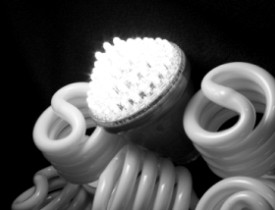CFL bulbs are the most popular, but LEDs might just be worth your investment. Find out why.

There are two main types of commercially available energy-efficient light bulbs: LEDs and CFLs. Both are better than traditional incandescent light bulbs when it comes to energy efficiency, but their practicality in consumer households is variable. So, to help you decide which bulbs are best for your buck, we have compiled the facts so that you can make an informed purchasing decision.
Comparing the Energy Efficiency of LEDs, CFLs and Incandescent Bulbs
You can determine the efficiency of light bulbs by comparing the amount of light produced to the amount of energy consumed. Your goal should be to find the fixture that emits the most light with the least amount of energy consumed - at the best price for your budget. However, leaving price aside, research shows that LED light bulbs are truly the most energy-efficient. LED bulbs produce 90 to 112 lumens per watt. Compact Fluorescent Lamps produce 40 to 70 lumens per watt, and traditional incandescent bulb fixtures only produce 10 to 17 lumens per watt. So, from a purely scientific point of view, LEDs are the most energy-efficient bulbs.
Compact Fluorescent Lamp (CFL)
Compact Fluorescent Lamps, also called CFLs, are the most popular energy-efficient bulbs. They have a lifespan of 8 to 10 years and cost about $4 per bulb. Fluorescent light bulbs used to be notorious for the odd color of light they produce. However, in recent years, fluorescent light bulbs have evolved and now come in a full spectrum of light colors that are ideal for kitchens, bathrooms and other rooms where abundant overhead lighting is needed. One of the main downsides to CFLs is that they contain mercury and therefore make safe disposal difficult.
Light-Emitting Diode (LED)
LED bulbs consume the least power and have the longest lifespan, lasting up to 40 or 50 years. LEDs cost about $36 per bulb. This kind of bulb is both energy-efficient and environmentally friendly, as it does not contain mercury or lead like CFLs do. LEDs also function much better than CFLs when it comes to using dimmer switches. The LED color spectrum is still in development. As of right now, LED bulbs only come in two varieties: cool white light and warm white light. Cool white light is used for task lighting and warm white light is best for accent lighting. The major downside with LEDs is the price. You get more bang for your buck, but many people aren't willing to give up that many bucks upfront.
A cost-comparison analysis done by Eartheasy.com shows that both LEDs and CFLs will save you upward of $10,000 over a 10-year period. The savings of consumers who use LED bulbs will add up to about $2,000 more. In the end, though, the choice comes down to your personal needs. If you can't afford to pay $36 per bulb at the start of your energy-efficient home makeover, or if you're looking for a wider spectrum of light color, then CFLs are the way to go. On the other hand, if you're looking for the most energy-efficient bulbs, LEDs are the choice for you.

No comments:
Post a Comment